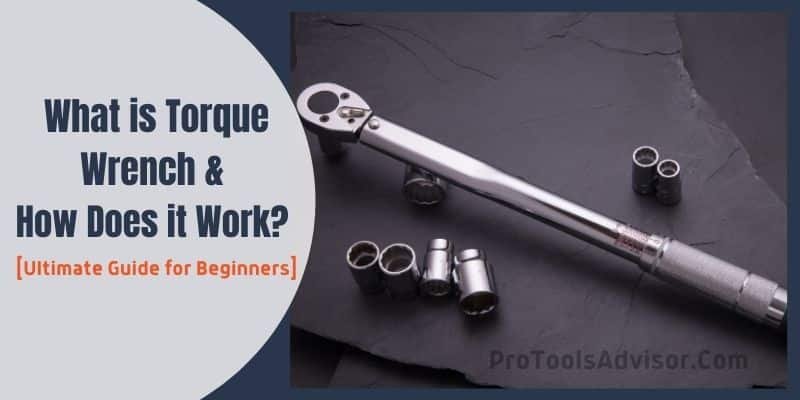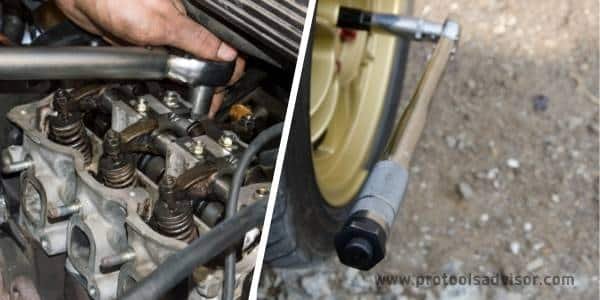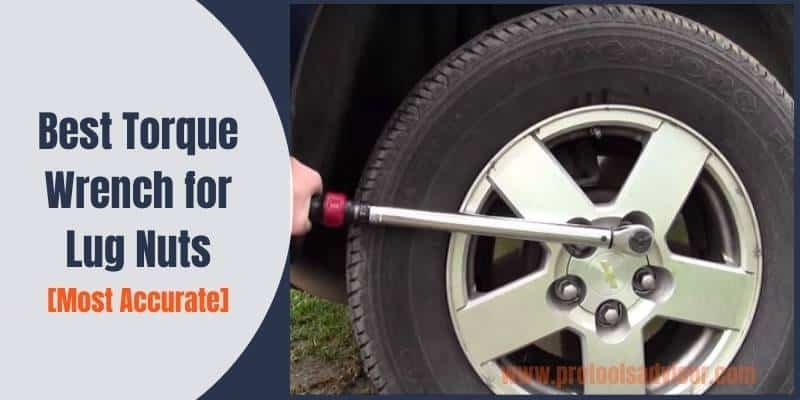Disclosure: This post contains affiliate links and I will be compensated if you make a purchase after clicking through my links. Learn More
Whether you are planning to build an auto repair shop or a family garage torque wrench is something you cannot ignore to have in your disposal. It is the most common yet the most useful tool for both hobbyist and seasoned mechanics.
Be it replacing tires, or servicing engines, you need to tighten nuts and bolts at some point and that is where the torque wrench comes in. It is a great tool to help you maintain the performance of your equipment.

There are several things to follow when using a torque wrench to ensure its longevity and the user’s safety. And that is why you need to understand how this tool works, how to use it correctly, and find the best torque wrench for your purpose.
Sounds complicated? Don’t worry. Today we will explore torque wrenches and everything that goes into the topic. So without further delay, let’s get started!
What is a Torque Wrench?
Torque wrench is a tool that lets you adjust the tension of screws, bolts, and nuts to a preset torque value. Generally looks similar to a socket wrench this tool is used in multiple applications sharing the same function. But the main difference is that torque wrenches come designed to apply a particular volume of torque. So it is easier to apply the correct tension to the fasteners, thus preventing damage from over tightening, or risk of coming loose due to under tightening.
The first version of this tightening tool was designed by Conrad Bahr in 1918. It was designed to avoid over-tightening the bolts installed on water mains and stream pipers in that period. Now you will see different forms of torque wrenches including electronic and manually controlled versions.
What is Torque?
If you are not familiar with the term ‘Torque’ it is a measure of force which causes an object to spin or stop it from spinning. There are two points to understand, the point where you push an object to rotate or stop it from rotating and the point (Pivot point) where it rotates around. The distance between the place of force and the pivot point is a straight line (axis of rotation) called the moment arm. And torque is derived by multiplying the moment arm with the force you apply.
Assume you’re trying to open a door. When you open the door, it will rotate around its hinges. And the closer you are to the door hinges, the less torque there is and the more difficult it is to open. One unit of torque can be measured in lb.-in. (pound inch), Nm (Newton Meter), or lb.-ft. (pound-foot).
Why Do You Need a Torque Wrench?

When you’re fastening screw, bolt, nut, or stud of different mechanical devices, each comes with a recommended torque specification. It is imperative to know the minimum torque level to be applied. Either overtightened or too loose, both can harm the performance of your equipment.
We can see the prevalent torque wrench use for automotive, home repairing, maintenance, and construction tasks. For changing the rims, setting bolt pulleys, sealing the mating flanges between a crush plate or gasket, or fastening the spark plugs of any powertrain engine or component, torque wrench is a must.
The main aim of using this tool is to ensure the user’s safety. It creates compatible tightening over an application to extend its longevity and expands its efficiency. For instance, if you over tighten the lug nuts on your vehicle wheel, it can lead to wobbles, possibly causing premature tire, brakes, tie rods, and ball joints wear. Also, an over-fastened center-lock nut on a whirling part can cause heat damage, excess resistance, and warping.
Torque wrenches are necessary to ensure a balanced rotation of components in wheels, flywheels, and driveshaft. It makes sure that any rotating parts with a center-lock nut such as wheel bearing, pulleys, and fans are not excessively tightened. Besides securing a proper seal level, torque wrench prevents steel mate flanges from being damaged.
It would be beneficial if you had a torque wrench to avoid cracking the exhaust manifold due to over tightening manifold bolts. Furthermore, by tightening the cylinder head bolt with a torque tool, severe coolant difficulties and costly damage can be prevented.
How Does a Torque Wrench Work?
Traditional torque wrenches generally require manual or scale adjustments before use. However, some latest models come equipped with digital components, making the adjustment much simpler.
Based on the materials to be screwed together, fastener’s activity, or available space, there are different categories of torque wrenches to fit in. They are available in a variety of sizes and shapes. The key features that differentiate them are the way they read torque and adjust nuts and bolts.
Torque Wrench Types and How They Works
Below we discussed six most common types of torque wrenches. Let’s explore how each of them works here-
Dial Torque Wrench
Dial-type torque wrenches offer a simple way of measuring torque. They were invented in the 1930s and have been the most accurate form of torque wrench ever since. They provide a direct measurement of torque using a mechanical system.
With a double-ended square drive these torque wrenches can tighten and loosen fasteners. The dial displays the torque value on an easy-to-read, analog, dual-range scale. There are two memory needles inside the dial. One needle is set to the target torque while the other needle is set to zero.
Once the user applies enough force the second needle starts to move across the dial. When the needles meet, the target torque has been reached. Dial type torque wrenches require less maintenance and calibration than click-type variants. They also signal with audio visual effects if the correct torque is reached.
Click Type Wrenches
You will come across different types of torque wrench on the market, but none come close to the popularity of click style torque wrenches. With their design, they are the finest solution for everyday torque restoration of nuts and bolts. To be honest, it’s difficult to find a mechanic who doesn’t like having a set of click-based torque wrenches in his toolbox.
This type of wrench comes with a scale marked on their body and a spring inside. By twisting the handle you can adjust your desired torque and put more pressure on the spring. You will have to rotate the handle till the zero is lined with the required markings on the wrench scale.
Add the socket to the fastener you intend to tighten. If it has less force that what you’ve set on the wrench you will be able to apply more pressure. When both of them strike a balance aka reach the preset torque the wrench will stop automatically and produce a “click” sound.
How Does The Internal Mechanism Work for a Click Type Torque Wrench?
Any click-type torque wrench will have a main socket adjustment point on the head that is part of a single long solid beam that extends into the outer handle. The outer handle is essentially a metal cylinder that is attached to the head at a pivot point. A mechanical clutch is located at the end of the inner beam, and a spring on the other side that applies compressive force to the clutch.
The spring force can be adjusted via the twisting handle. The more compressed the spring, the more power is required to drive the inner beam off its perch, or to disengage the clutch and to yield the audible click.
During normal use you’d set the torque wrench to a prescribed torque say 10 Newton meter which effectively puts a known and calibrated amount of compressive force on the inner spring. And when you turn the wrench and continue to increase the amount of applied force the thing keeping the outer handle from rotating about the inner beam at the pivot point is the clutch force which is modeled as a simple shear force.
Then at some point the clutch can no longer withstand that twisting force anymore and the inner beam slips off its perch and that’s when you hear and feel the audible click as the outer handle finally rotates about the pivot point and the inner beam strikes the inner wall of the outer handle. This is the indication that you’ve applied the proper torque to the bolt in question.
Hydraulic Torque Wrenches
Being an upgraded version of the traditional torque wrench, the hydraulic one is a tool with standardization that is able to measure the applied level of torque and obtain the desired tension or unbolt it.
Industrial applications using large bolts with high-degree accuracy, hydraulic torque wrenches are best for them. They are comparatively lightweight and have less noisy operations.
Square drive and low profile are two types of hydraulic torque wrenches. Both of them are designed for specific areas to use. These types of wrenches generate torque by applying hydraulic pressure. With a self-ratcheting mechanism, they can measure the torque level with precision.
Hydraulic torque wrench fits in different widths and heights of joints and nuts. Without interfering with the surrounding parts, it offers free and easy movement. A hydraulic stud bolt tightener or tensioning tool applies force to the bolt. This tool includes hydraulic high-pressure accessories and cylinders that are designed to adjust with the bolt and tighten the grip.
The applicable hydraulic pressure expands to the cylinder piston holding it in contrast to the puller that consecutively pulls the bolt. While the applied torque meets the bolt’s preload tension, it is knocked down, fastening it opposed to the joint. And, then the hydraulic pressure is turned to prevent the tensioner from turning back to its earlier position over the fastener nut.
Beam Torque Wrench
This style of torque wrenches comes equipped with two beams and a scale. This tool features a handle for employing force. Once you start to tighten a bolt, one beam moves when the rest (the upper one) remains in its place. This allows the stationary beam (looks like a needle or better you can say a pointer) to point a number (the torque level) in the scale which indicates the amount of force you apply. As the pointer doesn’t stop when you reach the correct torque level and you cannot set a specified torque on this tool you have a lot of room for error. That is why beam style torque wrenches are not the best choice for intricate works.
Split Beam
Due to their high degree of accuracy and less maintenance aspects, Split beam torque wrenches are also very common and popular among technicians. These wrenches work best on nuts and bolts that require precise factory setting.
Similar to the traditional beam style torque wrenches, split beam torque wrenches feature two beams, one called the main beam and the other is the anchor beam. The main beam is longer than the anchor beam and both of them come attached to the wrench head on one end, to a catch lever (the trigger) on the other.
These wrenches work by adjusting a (side) knob, and when you do that the internal pivot point moves. Since one beam tries to remain in place a force is created. When you start to tighten the fastener, this force aka the torque is then transferred causing the lever on the catch to be lifted.
Split beam torque wrenches don’t use the tension of a spring to apply any specific torque, which means you do not have to lower the preset torque after use. That’s why they don’t need to be recalibrated as frequently as a click style torque wrench.
Electronic Torque Wrench
Also acknowledged as a digital torque wrench, this tool doesn’t come designed with moving components, rather operable from electrical sensors. It comes with patented small chips containing memory sticks accessible on a computer. This device senses the amount of applied twisting torque and shows the user through a digital display.
For newbies, this type of torque wrenches is convenient and straightforward. It can run by either electricity or a battery. To operate an electric torque wrench properly, ensure the setting is proper after powering it on. Set the torque level on the display, plug in the socket to the faster, and hold on to the trigger. Once the torque is reached, it will show on-screen and flash an LED indicator.
Torque Wrench Size
There are four most commonly used torque wrench size available on the market-
- 1/2 Inch Drive
- 3/8 Inch Drive
- 1/4 Inch Drive
- 3/4 to 1 Inch Drive
Each gearing towards particular tasks. if you want to know more what size torque wrench should you buy then read this article.
Others 7 Things You Should Know About Torque Wrench
We have pointed out several key factors that you should be aware of in a torque wrench here:
- It would help if you choose a torque wrench with a +/- 5% accuracy.
- Check the calibration of the torque wrench for accuracy and date according to the manufacturer’s settings.
- As the accuracy of the torque wrench can deteriorate with time and use, it is essential to calibrate tools after reaching 2,500 repetitions.
- To avoid accidental setting adjustment, you should apply the adjustment lock before operation.
- You should follow the marked loading points designed on most of the wrench’s handles.
- As most torque tools follow a clockwise manner, check out the specifications before turning it counterclockwise.
- Since plastic can break easily, go for wrenches made of sturdy metallic materials.
How Do You Use a Torque Wrench?
Before you search for the best torque wrench for your need, take a moment to check out the basics of using it here:
- It is a common thing done by the users to click the wrench more than once while tensioning a bolt. But, this added force hinders your torque wrench from performing smoothly.
- Avoid using any object to extend the handle of the wrench. It can lead to accuracy discard and tool damage.
- Torque tools are compatible with both tightening and loosening bolts. However, divert to another device if you can’t make it slacken within the wrench’s maximum force.
- Follow the required force provided by the manufacturer for your equipment while adjusting the wrench.
- You can take the help of a calculator app available on Android and IOS for converting force units.
- Use the loading point marked on the wrench’s handle for accurate results.
- You should not exceed the highest level of torque limit. Otherwise, it can affect the wrench’s accuracy and cause trouble for future use.
Final Verdict
From a home mechanic to a seasoned expert, torque wrench is undoubtedly the most useful tool to have in the inventory. Although there are a few alternatives available like adjustable and combination wrenches, when it is a question of tightening nuts and bolts to the utmost precision torque wrench is the best tool.
That being said, remember that one item may not serve you in every application equally well. And that’s why different types of torque wrench exist.
However, when it comes to the best torque wrench we would go for LexiVon Click Type Model without any hesitation.
While regular torque wrenches loss calibration in a short span of time, this intelligent tool holds a strong reputation. Developed by America’s best engineers it contains the latest innovation in torque wrench design. It is capable of measuring torque in extended range and you can rotate this in both ways (clockwise and anticlockwise). So coming to the end, if you are a newcomer, we believe this article has helped you understand what a torque wrench is and how it works. Explore other articles on our website and hopefully you will learn more about this incredible fastening tool.


